Darrell Brooks trial: Week 2 recap, emotional testimony, victims who died

Darrell Brooks trial: Defendant's arrest prosecutors' next focus
The jury in the Darrell Brooks trial now knows how each of the six people died at the Waukesha Christmas Parade and what happened to the dozens more that were injured. Prosecutors will focus next on Brooks' arrest. As the trial heads into its third week, the jury is expected to get an up-close look at the red SUV.
WAUKESHA, Wis. - Witness testimony resumes Monday morning, Oct. 17 in the Darrell Brooks trial, charged in the November 2021 Waukesha Christmas parade attack. This, after the first full week of testimony during the second week of the trial, including emotional testimony about the six who were killed and the more than 60 others who were hurt during the Christmas parade attack.
The second week of the trial was much different from the first, in that we saw Darrell Brooks remain in the main courtroom the entire week. He was moved to an adjacent courtroom every day during the first week of the trial due to repeated interruptions. At one point, we saw Brooks take off his shirt in the courtroom next door and sit with his back to the camera.
SIGN UP TODAY: Get daily headlines, breaking news emails from FOX6 News
During the second week of the trial, we saw Brooks in a suit and tie Monday-Friday, and he even offered an apology to the court for his actions during Week 1.

Darrell Brooks trial: Defendant apologizes to the court for his actions during trial
Darrell Brooks apologized to the court and everyone involved in the proceedings for his actions during trial in the first week.
"I just want to state this for the record that I would like to issue the court an apology from me in regards to my actions last week during the trial," Brooks said Monday, Oct. 10. "I just want the court to understand it's very emotional right now, not only for just the whole situation of the trial, the families here that have to go through, you know, everything that's going to be involved with the trial, but also my family, as well, myself. It's very, very emotional but not to excuse my actions, and I should carry myself with better respect. I wasn't raised that way, and I owe you, your Honor, and the court an apology."
Brooks went on to say, "And I want to stand up as a man and tell the whole court and you, your Honor, I want to apologize to the bailiffs that I want to apologize for my actions. Like I said, that's not how I was raised. I come from a Christian background. My mother did not raise me that way. She did not raise me to act out of frustration and irritation and anger, and I just wanted everyone to know that I apologize for my actions, and I'm going to try my best to, whatever happens, to conduct myself with respect and with respect to the court, and I just wanted you all to know that. The prosecution, the judge, bailiffs, clerks, reporters, everybody, audience, everybody here. I just wanted you all to know that."
Despite the apology, there were still interruptions and arguments from Brooks during the second week of the trial; mainly regarding his "sovereign citizen" arguments and the issue of "subject matter jurisdiction." In fact, on Monday, Brooks brought up several court cases regarding subject matter jurisdiction, and later in the week, Judge Jennifer Dorow issued a written ruling on the matter.
MONDAY, Oct. 10
Before Brooks' apology in court on Monday morning, there was a discussion about video shown by the state from a fight at Frame Park involving Brooks, his ex-girlfriend, Erika Patterson and her roommate, Kori Runkel. Brooks claimed he heard Patterson make a statement in Waukesha Police Officer Jeremy Philipps' dash camera video about how Brooks ran her over with a car, which he's charged with doing in Milwaukee County. That prior incident was prohibited from being discussed in court during the Waukesha parade trial.
Judge Dorow agreed with Brooks, saying she gave a very clear ruling in regard to other acts being discussed during this trial. She noted a redaction could actually highlight that portion of the video for the jury.
The state called seven witnesses Monday.
TESTIMONY: Waukesha Police Detective Thomas Casey
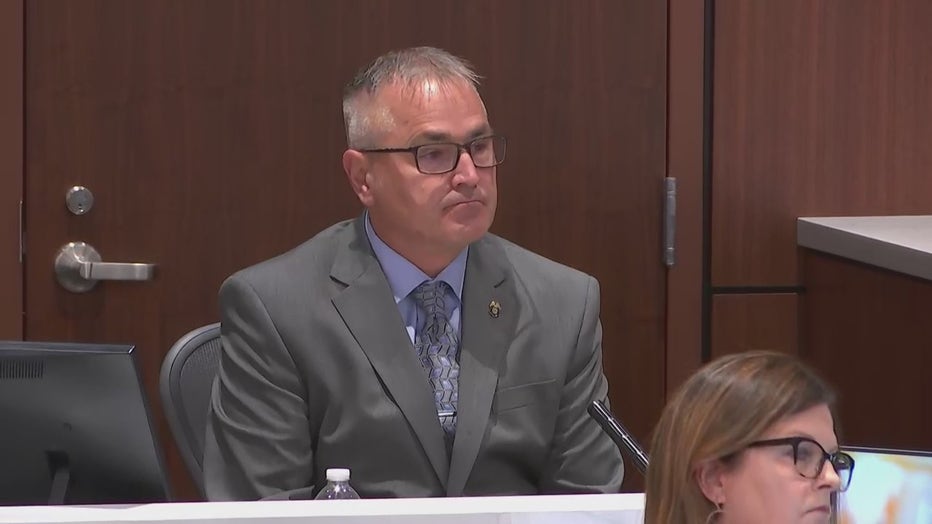
Thomas Casey
Testimony Monday morning began with Brooks cross-examining Waukesha Police Detective Thomas Casey, who had previously testified for the state on Friday.
Detective Casey walked the jury through videos of the parade incident. Casey got a description of the driver.
On cross, Brooks asked Casey if he knew what the driver was wearing. Casey said he did not. Brooks also asked Casey if he saw the red SUV strike anyone at the parade. Casey said "no."
"Fair to say there were hundreds of people around? And you didn’t see anyone be struck?" asked Brooks.
"No, I did not," said Casey.
Brooks also asked Casey about his statements that he heard the SUV's horn blowing.
"Would you say that was trying to indicate people to its presence?" asked Brooks.
The state's objection was sustained by the judge.
Casey was shown a photo prosecutors say shows Brooks behind the wheel. Casey said the vehicle "never stopped" as it went past him at White Rock and Main.
TESTIMONY: Waukesha Police Officer Bryce Butryn
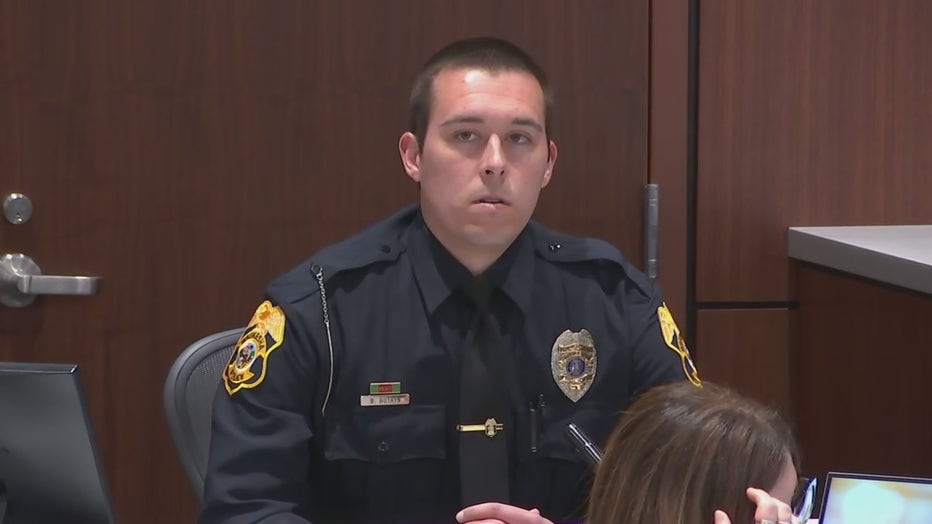
Office Bryce Butryn
Officer Butryn was stationed at Main Street and North East Avenue near the parade entrance. He testified he heard a vehicle honking and headed toward him. He raised his hand to direct the vehicle to stop but said it went around him, "going 30 to 35 miles per hour."
The officer said after the vehicle passed him, he saw "items flying into the air."
"There was so many things flying, I don’t know what was being struck," said Butryn.
He said after people were hit, the driver did not stop the check on people.
Afterward, Butryn noted that "there were multiple casualties on both sides of the road. Varying injuries. Chaos. People pulling at me needing help."
Butryn said he was present where the SUV was later found and discussed a hat found on the ground. A picture was shown.
During cross-examination, Brooks asked Butryn whether he saw the vehicle hit anyone, and Butryn said "no." He said he was not injured in the incident.
Brooks asked Butryn repeatedly whether he heard the vehicle honking, and video was replayed for Butryn.
TESTIMONY: Waukesha Police Officer Sonia Schneider
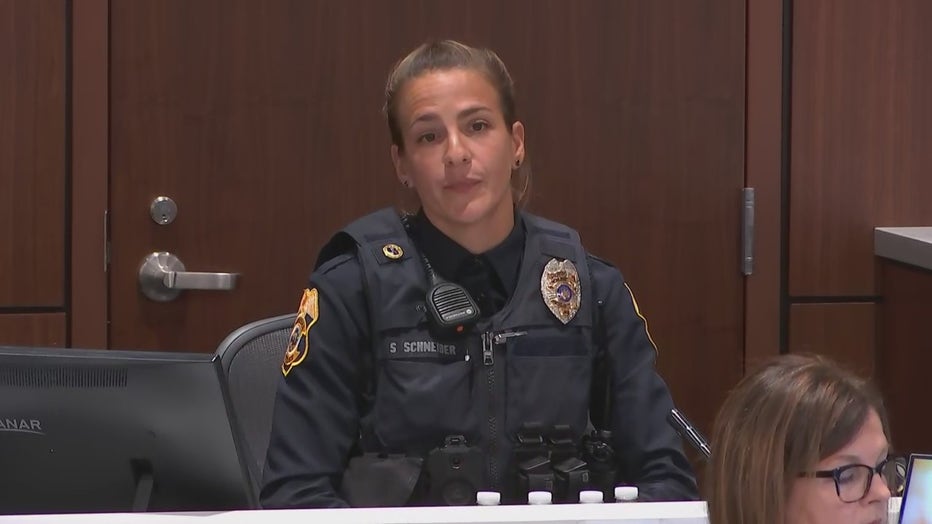
Officer Sonia Schneider
Officer Sonia Schneider testified she heard radio traffic about a vehicle going through barricades. She said she stepped directly into the path of the SUV and tried to direct the driver to exit at Buckley Street but had to jump out of the way.
Schneider testified that the SUV's driver had time to slow down and turn off the parade route onto Buckley.
"I tried to direct the vehicle off to Buckley," said Schneider. "I stood directly in the path of the SUV."
"Did you say anything or gesture to the vehicle?" asked Waukesha County District Attorney Sue Opper.
"I tried to get the driver to observe me in the street," said Schneider, adding that she had to "jump out of the way."
She described the driver as an "African American male with brown eyes and brown hair."
"He had no expression – looking straight ahead like he was looking straight through me," said Schneider.
Schneider said she never heard the SUV's horn.
Afterward, Schneider said she was "stopped by many people who had kids hit." One of them was Jessalyn Torres, a member of the Waukesha Xtreme Dance Team. She said Jessalyn's injuries were significant.
Schneider said she was then asked to stand guard over one of the deceased -- a member of the Milwaukee Dancing Grannies.
On cross, Brooks asked whether she heard a horn honking.
"I don’t have any information about honking," said Schneider, adding that the vehicle was "driving in a straight line."
TESTIMONY: Waukesha Fire Department Battalion Chief Jim Haakenson

Battalion Chief Jim Haakenson
Battalion Chief Haakenson testified he heard a call about a man with a knife in Frame Park at the start of the parade but could not respond in time because they were scattered throughout the parade. Chief Baakenson also said they sounded a MABAS box alarm for assistance with parade victims.
TESTIMONY: Nicole White, 1st person hit by SUV

Nicole White
Nicole White walked in the parade with RE/MAX. She testified she was struck from behind by the SUV, which rolled over her legs.
White said she didn't know anything was wrong that day until she was hit.
"When I looked up, the vehicle just continued," she said.
She said she didn't see brake lights and did not hear a horn.
She said she did not get a license plate number for the SUV.
During cross, White appeared to be nervously shaking and uncomfortable on the stand. She was the first parade attack victim to be cross-examined by Brooks.
TESTIMONY: Sarah Wehmeier-Aparicio, Waukesha South band director

Band director takes stand for state in Darrell Brooks trial
Sarah Wehmeier-Aparicio, Waukesha South band director in November 2021, took the stand for the state in the Darrell Brooks trial. This was part of her testimony.
Sarah Wehmeier-Aparicio, then Waukesha South High School’s band director, said she witnessed the SUV running over band members after it passed "within two feet" of her, personally. She thought at first it was an accident, but then saw the driver "staring straight ahead" as he continued past the band.
"All the sudden, I thought I heard something... there was some sort of vehicle trying to get through," she said.
She said she then saw things "flying through the air."
Ten members of the Waukesha South band were hit near the gelato shop. Video was played in which band noise turned to screaming.
"There were many broken bones, internal bleeding, dental work, stitches, sprains…" she said.
On cross-examination, Brooks asked Wehmeier-Aparicio whether she was injured.
"I was not. Fortunately, I moved just in time," she said.
She was asked whether the sound of the band would have impaired her ability to hear, say, the sound of a car horn.
Wehmeier-Aparicio answered that she believes she would have been able to hear a car horn, telling Brooks it would have been "an unexpected sound."
TESTIMONY: Kyle Jewell, Waukesha Christmas Parade attendee
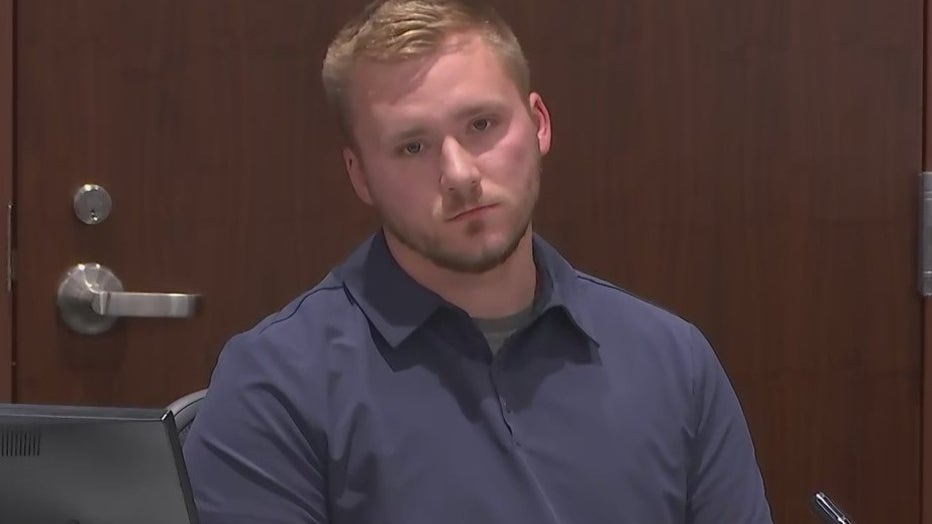
Kyle Jewell
Kyle Jewell attended the parade with his family. He described the SUV going over what appeared to be "speed bumps" but realized they were human bodies. Jewell said he ran after the SUV for "a good distance" attempt to stop it but was unable to catch up.
He said it was a red SUV that "went straight over the Waukesha South band."
"I saw what looked like it went in the air over a pretty big object… It just looked like a big speed bump and kept going," said Jewell.
He said his reaction was to "go after it," but he wasn't fast enough.
"It drove off at a pretty good rate of speed," he said.
Jewell said he didn't hear the horn. The vehicle didn't stop.
"Really, what’s going on? Normally, you don’t see a vehicle going that quick down a parade route," he said.
Brooks had video played for Jewell and asked whether he heard a horn. Jewell said he did not.
On cross, looking at the police report, Brooks asked Jewell to confirm he did not get a description of the driver, and he said he did not. He also did not get a license plate number. He said the back windows were tinted, and he could not see into the back of the vehicle. Jewell said "yes" when asked if he knew how many people were in the vehicle and "yes" when asked if that was true even though he couldn't see the entire inside of the vehicle.
"I could tell there was one person in the car. I could see that they were wearing some sort of hat or sweatshirt. That was about it," he said.
Jewell said the only people he saw struck were members of the band.
"Fair to say there were hundreds, even thousands of people for the parade?" asked Brooks.
"Yes," said Jewell.
"And you only saw a handful of people struck?" said Brooks.
Brooks had video played for Jewell and asked whether he heard a horn. Jewell said he did not.
TESTIMONY: Thomas Greene, parade attendee with family
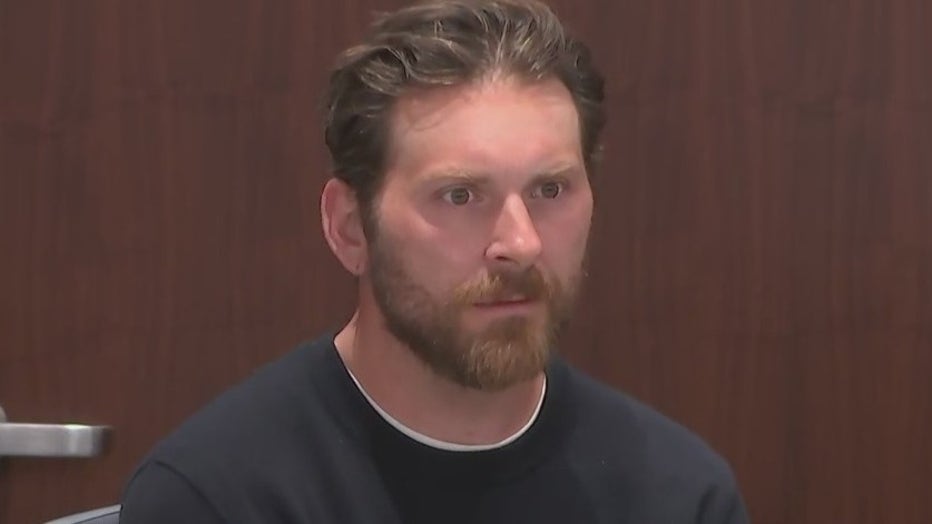
Thomas Greene
Thomas Greene attended the parade with his wife and three children. Greene testified that he watched the SUV run over members of the Waukesha South marching band before veering toward him and striking two of his children. Greene said the driver veered back into the parade route and kept going.
"We were just watching the Christmas Parade as we normally do. Go to a lot of parades as a family," said Greene. "I heard a loud crash noise to my right. I looked that way. I seen a car running over the marching band, and as soon as the car had run over the marching band, it swerved towards me and my family and then proceeded down the parade route."
Greene said his son and daughter were hit.
Brooks asked Greene if he saw the driver of the SUV.
"I seen someone in a hoodie with dark skin," said Greene, adding that he did not see anyone else in the vehicle and that the back windows were tinted. He said he didn't get a license plate number. He said it was "hard to say" how fast the SUV was going. He said he didn't see the vehicle strike anyone else. He said he and his wife weren't hurt.
On cross, Brooks questioned Greene on his statement that the driver was "tan-skinned" as opposed to his prior testimony Monday that the driver was "dark-skinned."
On re-direct, Greene was asked about his initial thought that this was an accident.
"Once the vehicle kept going after hitting the band, I realized that it was not part of the parade," said Greene.
Greene was asked what led to that realization.
"The speed at which it accelerated," said Greene.
TUESDAY, Oct. 11
Tuesday began with more discussion about Brooks' "sovereign citizen" arguments and subject matter jurisdiction, specifically the case law Brooks cited.
Judge Dorow again told Brooks his "sovereign citizen" arguments "have all been debunked throughout the ages in the courts of the United States of America, both in state court and in federal court."
The state called seven witnesses Tuesday.
TESTIMONY: Kelly Grabow, Waukesha Christmas Parade attendee
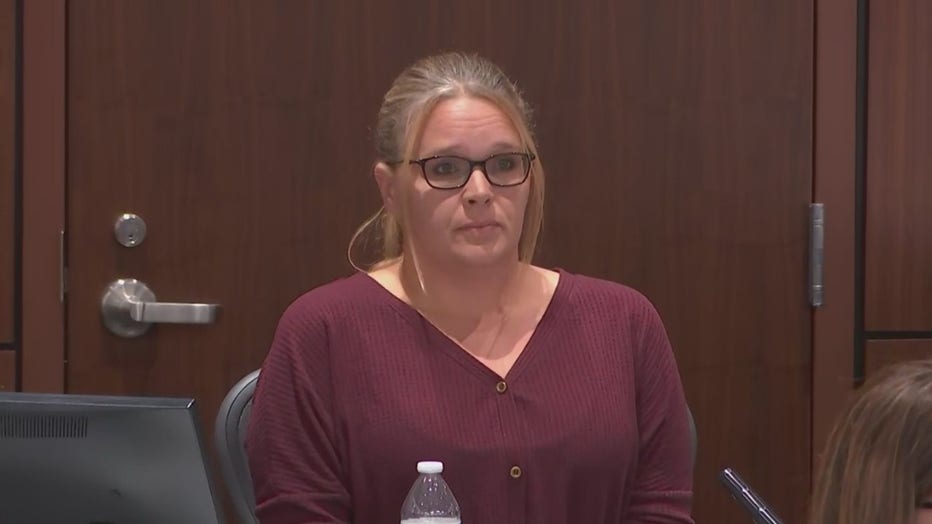
Kelly Grabow
First to testify Tuesday for the state was Kelly Grabow, who attended the parade with her daughter. Grabow was walking with Burris Logistics, just behind the Waukesha Blazers baseball team. She said the SUV knocked her to the ground. She then saw her daughter in the street and her daughter’s shoes "down the road."
"As I turned all I saw was the hood of the red vehicle," she testified. "I landed and saw the tire roll past my face."
Grabow talked about how she ignored her own injuries until she knew her injured daughter was safe at home.
During Brooks' cross-examination of Grabow, he asked if she saw the driver.
"No, just the red hood as it ran into me," said Grabow.
She couldn't estimate the speed.
"It all happened so fast…" she said.
She said she didn't hear a horn, and she didn't see if anyone else was struck.
"I did not see anywhere besides the tire going in front of my face," said Grabow.
Grabow also mentioned what she described as the "adrenaline" felt in the moment as she tried to help her daughter and said she heard shots fired.
TESTIMONY: Jeff Rogers, Waukesha Blazers baseball coach
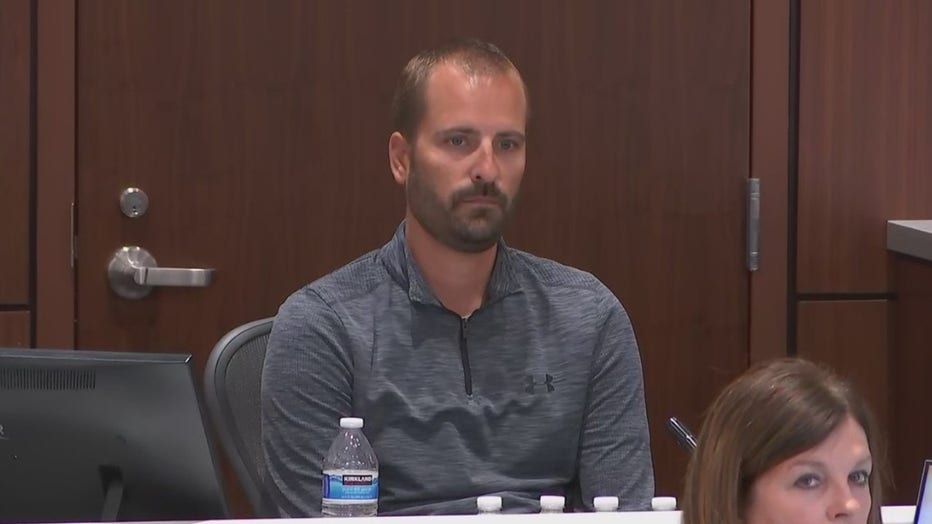
Jeffrey Rogers
Jeffrey Rogers, president of Waukesha Blazers Baseball, said when he saw the red SUV, he grabbed his daughter and then lost her. He found 8-year-old Jackson Sparks lying on the ground motionless. Sparks died from his injuries. Two of Rogers’ children were hurt.
The coach described Sparks as "motionless on the ground" after the SUV came through. He said he later found out the boy died. He said Jackson's brother, Tucker, who was walking by him at the parade, suffered a head injury.
He said the SUV did not stop. He said shortly after impact, someone said shots were fired, so he and two of his three kids went into a nearby antique store before he went back outside to look for Riley, his missing daughter. He then saw Jackson Sparks on the ground; someone giving CPR to the boy.

Jackson Sparks
Before cross, Brooks appeared to be wiping tears from his eyes, pulled something from his Bible and said: "I apologize to the witness. I'm a little emotional right now."
Brooks asked Rogers why he didn't identify the driver or get the license plate number, to which Rogers answered "because people were being struck."
Brooks asked Rogers why he didn't help any of the injured parties.
"I was concerned about my daughter missing," he said.
TESTIMONY: Joshua Kraner, Slammers baseball coach
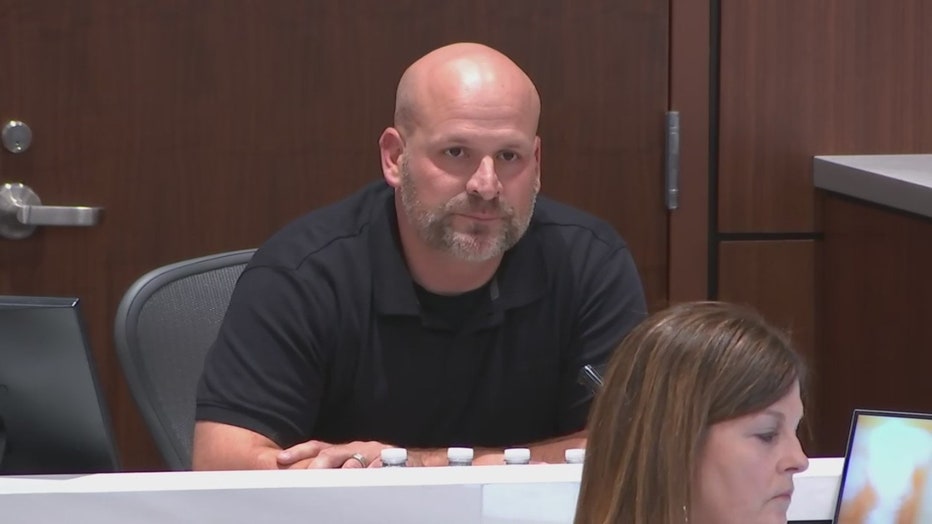
Joshua Kraner
Joshua Kraner, head coach of Slammers was walking with the Waukesha Blazers in the parade. Kramer was struck and hospitalized. His son was not injured.
"I instantly tried to find my son," Kraner testified, as to the moments after a red SUV drove through the parade. His son was not hurt in the incident.
Kraner said he was knocked to the ground and remembered "tires going by." He ended up in the hospital with contusions and bone bruises, he said, adding he "couldn't walk."
Brooks asked Kraner during cross-examination if he got a look at the SUV's driver or the license plate. Kraner said "no." Brooks also asked Kraner if he saw any reports of the "alleged defendant" in the case in the news, but the judge cut Brooks off – "next topic please" – before excusing the jury to ask Brooks why his question was relevant.
TESTIMONY: Alyssa Gajewski, Waukesha Xtreme Dance Team coach

Darrell Brooks trial: Xtreme Dance Team coach's emotional testimony
Alyssa Gajewski broke down into tears on the stand in the Darrell Brooks trial Tuesday, recalling the moments after "a car that drove through" the Waukesha Christmas parade, striking her young dancers.
More emotional testimony Tuesday came from Alyssa Gajewski, Waukesha Xtreme Dance Team coach, who broke down on the stand while discussing the 15 members of her group who were hit.
Gajewski broke down into tears as she described "a car that drove through" the parade. She talked about how she found her girls after they were hit and their conditions in the "overflowing" hospital.
Prosecutors showed Gajewski slowed-down video of the SUV driving through the parade. In that video, when asked by the state, Gajewski identified Jessalyn (Torres) – a member of Xtreme's junior dance group, who was hit and injured.
"I picked her up as soon as her body was in front of me," Gajewski said. "I didn't know if there was going to be a bunch of cars – I just wanted to get her out of the way."
Gajewski also testified about victims who were taken to the hospital and the condition they were in.
Before the lunch break Tuesday, the judge had a discussion with Brooks regarding his repeated "hearsay" objections.
"Your hearsay objections are not hearsay. I hope you are not saying them just to interpose an objection," said Judge Dorow, pointing to the statute book.
In cross-examining Gajewski after lunch, Brooks asked if she actually saw the SUV hit people.
"I remember seeing bodies in the air and on the ground," she said.
She added that she blacked out during the incident.
"Was that the first time you ever had a blackout?" asked Brooks.
"Yes," she said.
"Any idea what caused it?" asked Brooks.
"Stress. Shock," she said.
On redirect, she described the scene for prosecutors: "Just pure chaos, poms everywhere, bodies, people screaming. Just chaos."
TESTIMONY: Jaimie Sutton, Xtreme Dance Team coach
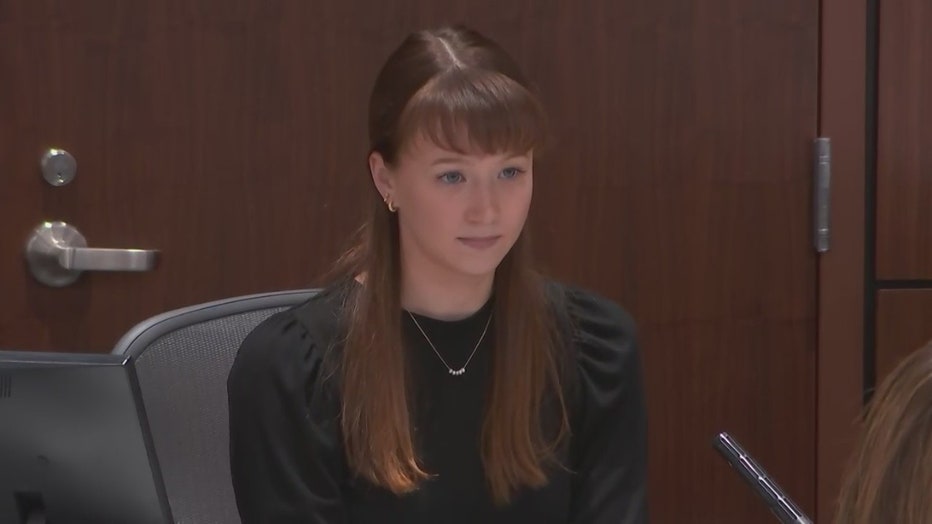
Jaimie Sutton
Jaimie Sutton, another Waukesha Xtreme Dance Team coach, testified that by the time she looked in the direction of the red SUV, "it was already hitting our girls." She said she then heard there was an active shooter, so she and the girls she was able to gather went inside Chef Pam's Kitchen.
Sutton identified her dancers in the video and said she was toward the back right side of the group.
"I was in the back right with our younger teams, helping them get into formation," said Sutton. "I heard yelling, looked over my left shoulder, there was a red car. By the time I looked, it was already hitting our girls."
On cross, Brooks also asked Sutton whether she identified the vehicle as a car or an SUV.
"It was an SUV," she said. "I identify all vehicles as cars."
TESTIMONY: Waukesha Police Detective Mike Carpenter
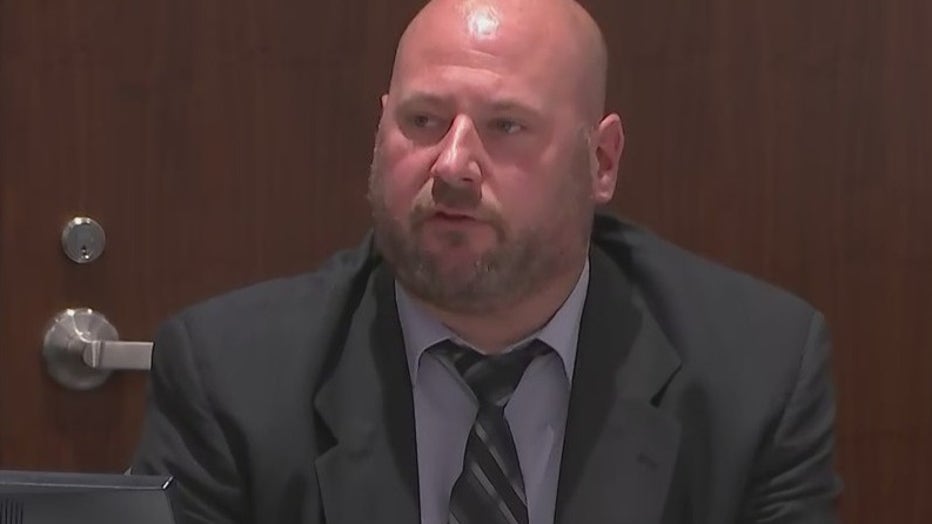
Waukesha Police Detective Mike Carpenter
Michael Carpenter, Waukesha police detective, testified on his speed analysis, using video and 3D technology to determine how fast the SUV was going. He said it was between 33-34 MPH based on distance measurements. It was his first time doing this for a live investigation.
On cross, Brooks questioned Carpenter as to whether "sometimes, the exact timing of speed could be a little inaccurate?"
"No, I don’t believe that properly characterizes it," Carpenter said, referring to the variable frame rate of digital recording systems. "To do this in the most accurate, scientific way possible, that’s why we conducted it … the way that we did."
Brooks asked if Carpenter had used this process before, and he said not in a live case but he had done it "a number of times." He discussed his many hours of training. Brooks then asked the difference between a live case and any other case.
"There really is no difference. The training we use is hands-on … the way we’d do it is exactly the same," Carpenter said.
Brooks also asked why this video analysis wasn't done until August.
"I believe in January, when we first started looking at this, we had to obtain funding, schedule training, wait for the company to post the training," he said.
He added that COVID increased the delay due to the availability of classes.
On redirect, Assistant District Attorney Zachary Wittchow asked if Carpenter were able to take the same Boscos video recorded during the parade today and start his calculations, he would come to the same MPH conclusions. Carpenter said "yes."
TESTIMONY: Debora Ramirez, Waukesha Christmas Parade attendee

Debora Ramirez
Debora Ramirez testified that she was at the parade with her boyfriend, their four kids and her dad. Ramirez and her son, Isaac, 12, were hit by the red SUV.
Ramirez said at one point during the parade, her boyfriend yelled and screamed.
"I looked to my right, and that’s when I saw a red vehicle coming right toward us," she said. "It was a red SUV. That’s all I remember."
When asked what she did next, Ramirez said she "froze."
"All I remember was hearing the vehicle speeding past, speeding past us, towards other people, and looking all around me, I just remember seeing a lot of people on the ground as I was looking around to see if my kids were OK," she said.
She said she does not remember the brakes being hit on the SUV.
"I remember hearing it accelerate instead of stopping…" she said.
On cross, Brooks asked Ramirez why she waited until the next day to go to urgent care.
"I was trying to find my other child, who was at the parade but not like, right with me," she said.
She also said she knew how many people had been injured, including "how many people were in the ground, needing immediate help."
"I chose to wait until the next day since I knew I was hurt, but I did not need immediate attention as other people did," she said.
Brooks asked if she sought to make a report the night of the incident. She said "no."
"I was in shock," she said, adding that when she got home, she basically had a mental breakdown and didn’t think of anything else.
She said she did not see the driver or the license plate number. She also said she didn't see the SUV hit anyone after it passed her.
WEDNESDAY, Oct. 12
Wednesday started out with the notation by the court that Brooks had filed his 13th subpoena, which was formerly going to be for a Waukesha Christmas parade organizer, but she has relocated to Texas. Brooks told the court "he's broke" and wouldn't know how to arrange travel from jail. Instead, Brooks sought to call the state of Wisconsin to testify.
Judge Jennifer Dorow noted, "That's an entity, not a person, sir."
Brooks then made his "sovereign citizen" and subject matter jurisdiction arguments again.
Brooks' witness list was obtained by FOX6 News Wednesday:
- Kathleen Yourell
- Erika Patterson – previously testified for the state
- State of Wisconsin (denied)
- Katrice Babiaz
- Heather Riemer
- Jason Hayes
- Juan Marquez
- Douglas Kolar
- Nicholas Kirby
- Abel Lazcano
- Chris Bertam
- Deanna Aldrich
- Steven Guth – previously testified for the state
Five witnesses testified for the state Wednesday.
TESTIMONY: Stefanie Bonesteel, Waukesha Christmas Parade participant
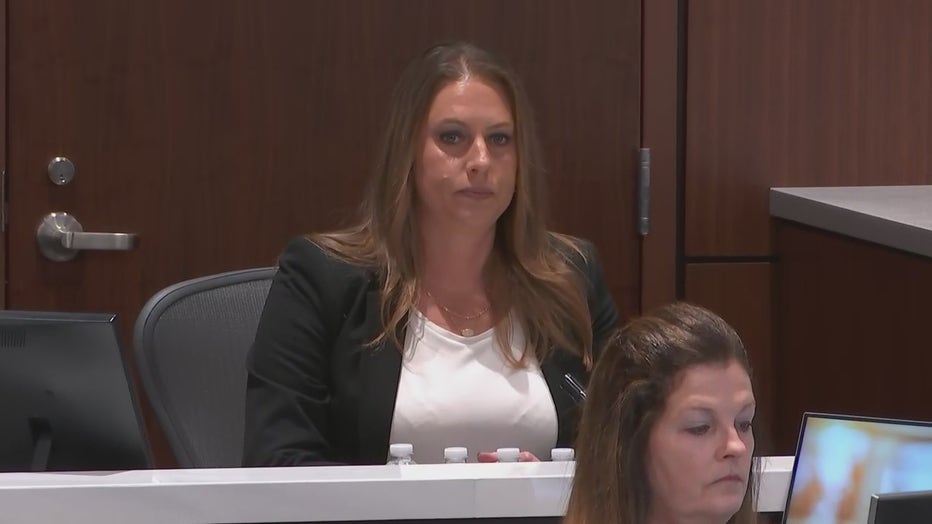
Stefanie Bonesteel
First to testify for the state Wednesday was Stefanie Bonesteel.
Bonesteel walked in the Waukesha Christmas Parade with co-workers with Citizens Bank and her two kids, who were passing out candy. Her husband drove their float truck. Bonesteel testified about the death of Jane Kulich, who was part of her group.
Bonesteel said she saw headlights "coming straight at me."
"As it passed, I realized it was an SUV," said Bonesteel, estimating the SUV was within 3-5 feet of her.
Describing what unfolded, Bonesteel testified she saw someone from her group running who was wearing a red poncho and. From her viewpoint, she said she then saw the red poncho "above the roof of the vehicle" before the vehicle went out of sight.
On cross, Brooks asked if Bonesteel could identify the color of the SUV, or if she saw a license plate.
She answered: "Out of fear and panic – I wasn't able to."
She said she did not see the driver.
TESTIMONY: Adam Bonesteel, parade participant
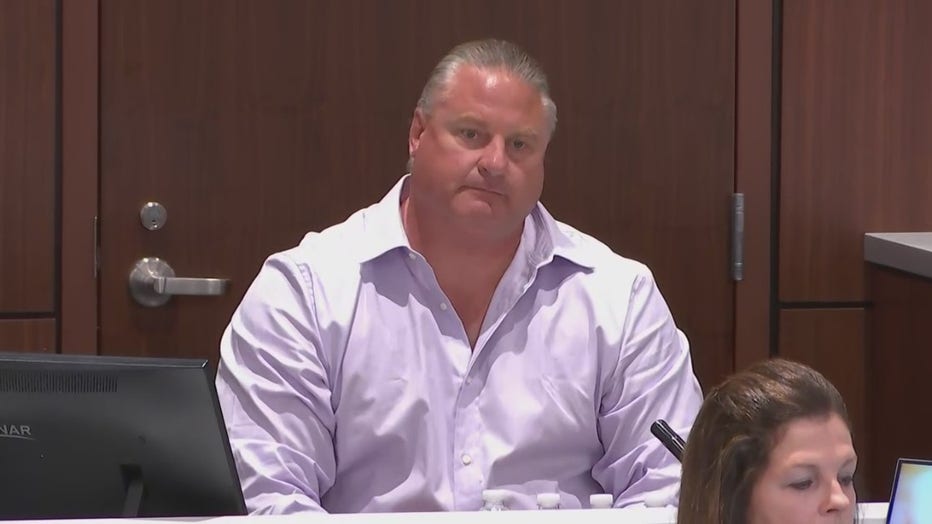
Adam Bonesteel
Adam Bonesteel drove the parade float for Citizens Bank. Bonesteel continued the testimony about the death of Jane Kulich, testifying that he "watched the body fly up onto the hood, her body snap back and I thought I could have reached out and grabbed her." He estimated the SUV's speed at roughly 30 mph.
Bonesteel testified that he saw "Jane (Kulich)" fall on the hood of a vehicle, and she was then run over. He estimated the SUV that hit Kulich was driving roughly 30 mph. He said he was going 2 mph.
"I thought my wife was the person on the car, said Bonesteel. "Then the body is on the ground. At that point, that was my only focus."
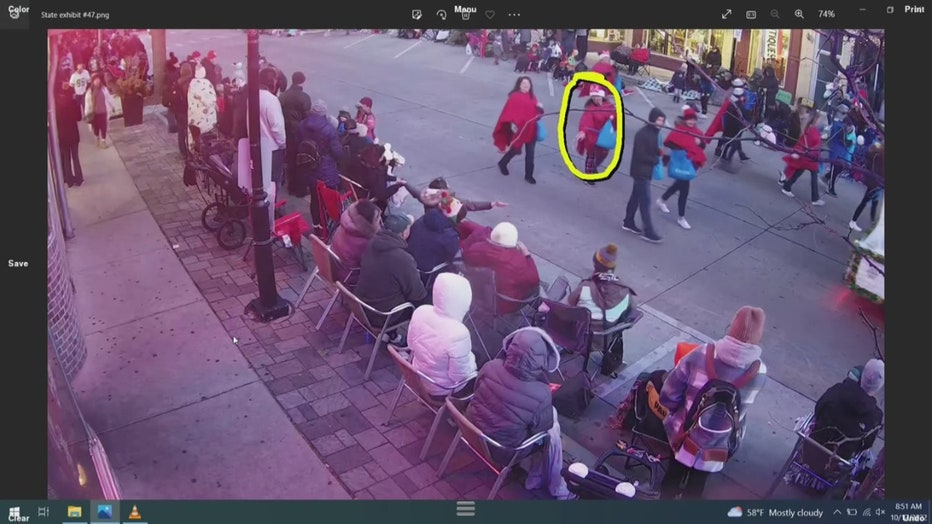
Jane Kulich walking with Citizens Bank group in Waukesha Christmas Prade, as identified by Stefanie Bonesteel in court on Oct. 12
Bonesteel said he later learned Jane Kulich had passed away.
"My gut feeling was she had passed," he said.
"Meaning when you went up to her?" asked Opper. Bonesteel said "yes."
Upon cross-examination, Brooks asked Bonesteel if he saw the driver of the SUV. Bonesteel answered he did not. Brooks then asked why Bonesteel identified the driver as "he" if he hadn't seen the driver. Bonesteel again testified he saw the SUV hit Kulich.
TESTIMONY: Matthew Harris, Waukesha Christmas Parade attendee
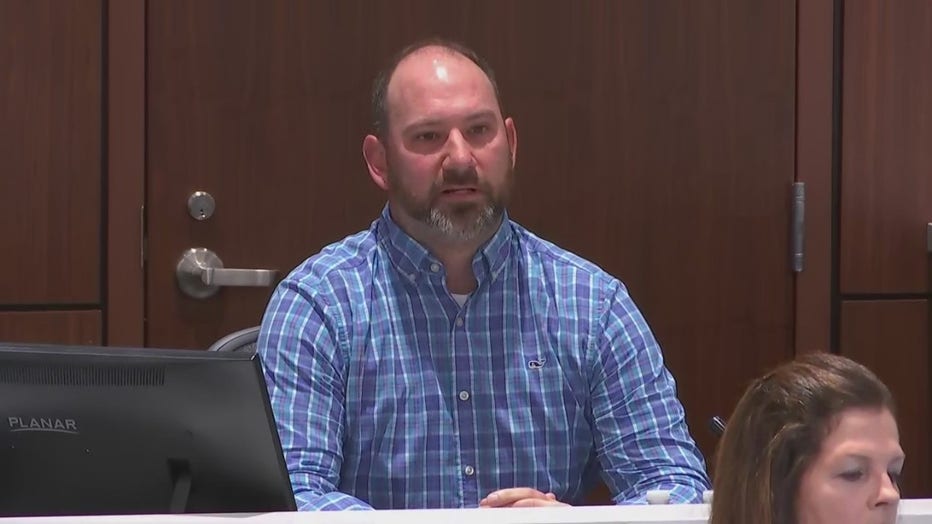
Matthew Harris
Matthew Harris attended the Waukesha Christmas Parade with a group, including his two daughters, ages 7 and 3. His daughter was injured. Another girl with their group was sideswiped. Harris described the scene as "mass chaos," noting he's a combat veteran and "had never seen anything like this."
Harris testified he did not hear a horn honking as the SUV came by.
During his cross-examination, Brooks asked Harris if he saw the driver of the SUV, got a license plate or saw tint on the windows; Harris said he did not, only noting the color of the SUV – red.
TESTIMONY: Heather Ricciotti, Waukesha Christmas Parade attendee
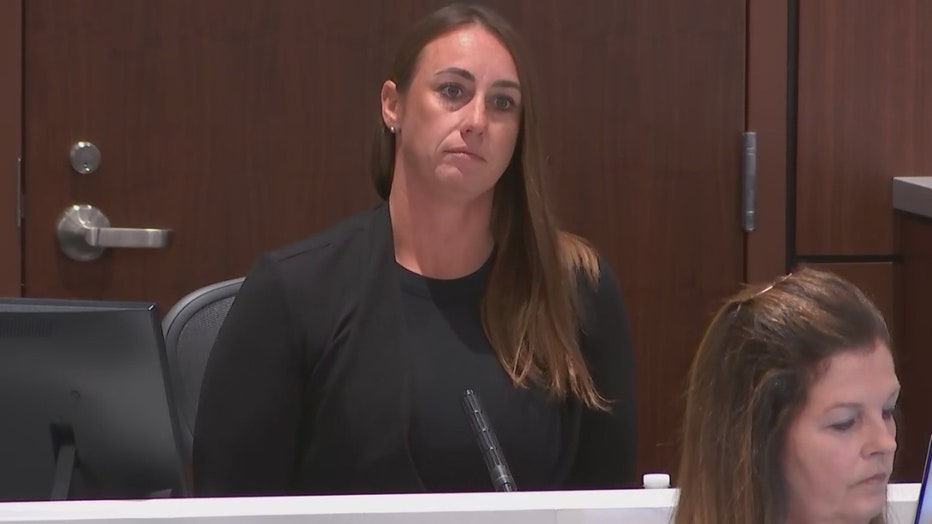
Heather Ricciotti
Heather Ricciotti attended the Waukesha Christmas Parade with her three kids, ages 7, 5 and 2. Her son, 5 at the time, was hit. She told the court that she "did not expect my kid to get hit at a parade."
"It was coming faster than any parade float should have – it was confusing," Ricciotti said of the SUV. "It veered into the crowd and my son got hit."
Brooks asked Ricciotti about the incident and why she did not follow up after speaking to law enforcement.
"I knew police were going to do their jobs," she said.
TESTIMONY: Daniel Knapp, parade attendee

Daniel Knapp
Daniel Knapp attended the Waukesha Christmas Parade with his wife and three kids, including a daughter who was hit. He explained how his daughter flew 15 feet and suffered an injury to her spleen and required facial surgery. He said he "locked eyes" with the driver. He described him as a Black male whose eyes were wide open.
"You looked eye to eye with the person who hit your daughter?" the prosecution asked.
"I did," answered Knapp.
Upon cross-examination, Knapp said he was roughly 20 feet away from the SUV when he locked eyes with the person inside it.
"From that distance, you were able to clearly lock eyes," asked Brooks.
"The vehicle was coming straight at me. I was able to lock eyes, yes," Knapp answered.
He said he wasn't able to get the make/model of the vehicle or notice what clothing the driver was wearing.
"I saw the face of the driver," he said. "I did not see pants or make out any shirt or jacket or any other markings."
Brooks asked about his testimony that the vehicle turned away after coming toward him.
"Why do you think the vehicle would be turning away from you?" Brooks asked.
Brooks also questioned Knapp about his police report, noting that he described the driver as an African American male with long hair and facial hair.
"I remember describing the driver of the vehicle that I made eye contact with as a Black male with facial hair," Knapp said. "I don't necessarily remember stating long hair."
There was then a discussion about skin complexion, with Brooks questioning Knapp about the fact that he said the driver had a dark complexion. Brooks said the person Knapp identified in court as the driver "does not have a dark complexion."
Knapp said it "depends on the definition of dark."
Brooks' cross-examination of Knapp was cut off by Dorow due to a tornado warning for Waukesha County.
Everyone was eventually dismissed early due to the severe storms that moved through and the disruption caused by the tornado warning.
THURSDAY, Oct. 13
Thursday saw emotional testimony about the six people who died in the Waukesha Christmas parade attack -- and a 50-minute rant from Darrell Brooks.
The day started with Brooks filing a "bond" document and requesting copies of the three criminal complaints in the case. The judge also referenced his repeated insistence that he "does not identify" by the name Darrell Brooks, saying, "You've never given me another name for which to call you."
Before the jury was brought in, Brooks again made his subject matter jurisdiction arguments.
The state called seven witnesses Thursday.
TESTIMONY: Laura Thein, Milwaukee Dancing Grannies

Darrell Brooks trial: Laura Thein, one of the Dancing Grannies, testifies
Laura Thein, one of the Dancing Grannies, testified in the Darrell Brooks trial.
First to testify for the state Thursday was Laura Thein, member of the Milwaukee Dancing Grannies.
Thein talked about the four members of her group that were killed: Virginia Sorenson, Bill Hospel, Tamara Durand and Lee Owen. Durand was marching in her first and last parade. Thein was walking with the group during the parade, and described the Dancing Grannies as a "sisterhood."
Thein spoke glowingly of Virginia Sorenson, one of the Dancing Grannies who died.
"Ginny was our glue," said Thien. "She held the group together. She was with us the longest. She was close to everyone. We were like sisters."
Thein then proceeded to talk in detail about the other members of the Dancing Grannies who were with her on Nov. 21, 2021.
"All of us are very friendly," Thein said.
She talked about Bill Hospel, who died in surgery after the attack. His wife, Lola, is a Dancing Grannies member. Thein said Ginny carried the banner and Bill carried ice chips for them.
"Lola was the mother figure, the oldest -- just friendly with everyone," said Thein.
She talked about Lee Owen, who she said was "killed instantly," along with Ginny.
"Lee was very close to Ginny," said Thein. "She talked a lot to the new people coming in. She taught them the routines."
Thein said it was Tamara Durand's first parade. She was also killed.
"She was so excited about being a granny," said Thein. "She worked for months and months to learn all the routines. That was the first and last parade she ever did."
Thein said her own husband was driving the "music vehicle," which she was in front of. She said the red SUV came from the side and hit Bill and Tamara.
"I saw a streak of red going past," Thein said. "It just whizzed past me."
Thein said the vehicle struck multiple people.
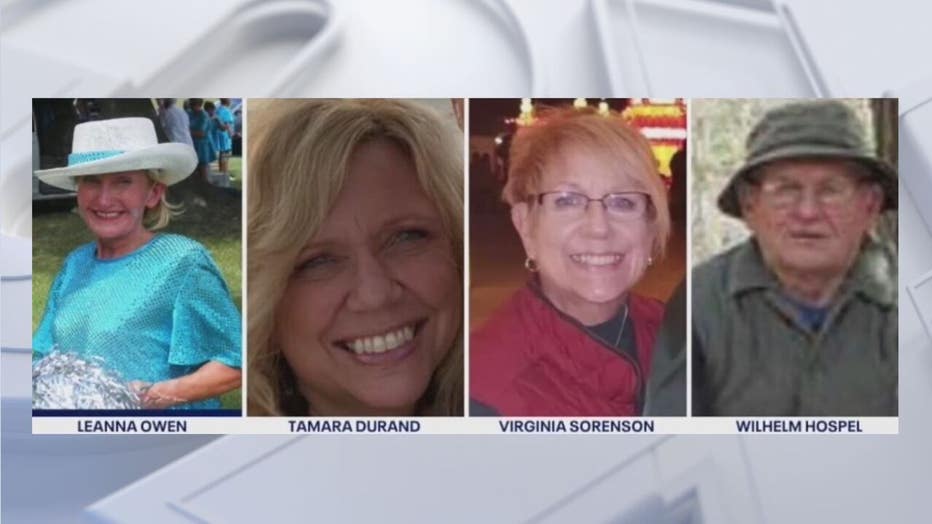
Milwaukee Dancing Grannies members killed in Waukesha Christmas parade attack
"I didn’t see them get hit. It happened so quick," said Thein. "I screamed in my head or out loud. I said, ‘What is he doing? Where is he going?’ It was so unusual. If he was going down the parade route, he was going to hurt a lot of people."
She said she never saw the SUV slow down.
"It came from the right, hit two people and came in the middle, hit two more people and hit two more," said Thein.
"After it struck Ginny, it was on the left side of the street, and it just kept barreling through," said Thein. "I looked around, and there were so many bodies on the ground. I thought I was in a war."
On cross, Brooks asked Thein about her referencing the driver as "he."
"You kept referring to a 'he, he, he.' Who did you mean by the 'he?'" asked Brooks.
"Bill would be the ‘he,’" said Thein.
Brooks asked if she got a good look at the driver of the red SUV.
"No, I don’t have eyes in the back of my head," she said.
She said she didn't know if she heard a horn.
The jury was then excused for a legal discussion about Brooks repeated requests for the court to state the "grounds" in overruling his objections.
"I am not legally required to do that," said Dorow. "If you feel there is an issue later on, you can address it on appeal if convicted."
Brooks' rant

Darrell Brooks trial: Defendant challenges court proceedings
Darrell Brooks was allowed to speak at length during his trial on Thursday, Oct. 13. He took the opportunity to question the entire proceedings. The court allowed him roughly 50 minutes to speak of these challenges.
As soon as the jury was brought back in after the morning break, they were taken out.
This, after Brooks again brought up subject matter jurisdiction. He also requested an affidavit that the judge has "no bias, no conflict of interest and no interest in the outcome of the case."
Judge Dorow said she would address his legal issues outside the presence of the jury if appropriate.
As the jury was taken out, Brooks continued to make statements.
Dorow told him to "wait until the jury is out, please."
"I ask that you show that respect," the judge said.
"I will," Brooks said.
After the jury was taken out, Brooks went on a 50-minute rant, calling for the case to be dismissed, the judge to recuse herself and even using the word "treason."
"There's so many clear biases and questions that are not being asked based on judicial determinations made by your Honor," said Brooks. "At minimum, I deserve for the subject matter jurisdiction to be verified and proven. I've raised that issue many times, pretty much every day. My filings have been disregarded. I haven't gotten written copies of any of them."
He went on to say, "I'm still not even understanding the nature and cause of the charges," asking, "How can the proceedings continue when there are so many things that haven't been provided?"
"I'm without so much information, valid information to this matter, and I believe that it should be verified and it should be proven for the record, and if not, I move for this case to be dismissed," added Brooks.
Opper responds to Brooks' rant

Darrell Brooks trial: Prosecution response to Brooks' challenge of proceedings
Waukesha County District Attorney Sue Opper responded to Darrell Brooks' questioning of all the court proceedings surrouding his trial.
Opper said Brooks "knowingly and willingly insisted on representing himself at trial." Opper called back to Brooks’ "it don’t make me flinch one bit" comment about acting in his own defense.
Opper said Brooks' sovereign citizen statements "are frivolous and wholly without merit." She brought up the fact that Brooks used the word "treason" and said it was "absolutely shocking that he would throw such a word around."
She said the prosecution had been "exceedingly patient" and "exceedingly respectful" of his rights at every turn.
Opper called Brooks' statement that he only had three days to prepare for the trial a "false statement." She noted the three "organized" boxes on his defense table. She said his public defenders "did all the homework," and he was simply "reading their notes and asking questions," including "his ridiculous questions having to do with the sovereign citizen movement."
"He is not going into this blind or with one arm tied behind his back," said Opper.
Judge responds to Brooks' rant

Darrell Brooks trial: Judge Dorow's response to defendant's challenge of proceedings
After allowing Darrell Brooks roughly 50 minutes to challenge the proceedings of his trial, the judge issued this ruling.
In her response, Judge Dorow said Brooks "raised a litany of complaints and issues regarding the case," and she said, "Many, if not the vast majority or all of them, have already been addressed by this court in one way or the other."
"To say this jury is biased is a complete mischaracterization of justice/the process this court painstakingly took in order to obtain a fair and impartial jury," said Dorow, noting "nothing on this record before the court throughout these proceedings to suggest this is a biased jury."
Judge Dorow went over the jury selection process and noted Brooks refused eight out of the 10 of his peremptory strikes of prospective jurors.
"There is nothing on this record before the court to suggest that this jury that we have is anything but fair and impartial, and I take issue with the characterization they are anything but," said Dorow.
She called Brooks' subject matter jurisdiction arguments "baseless" and "frivolous" and "not anything the court needs to address further."
The judge concluded by saying, "This trial will keep going."
TESTIMONY: Hope Evans-Jansen, Waukesha Christmas Parade attendee
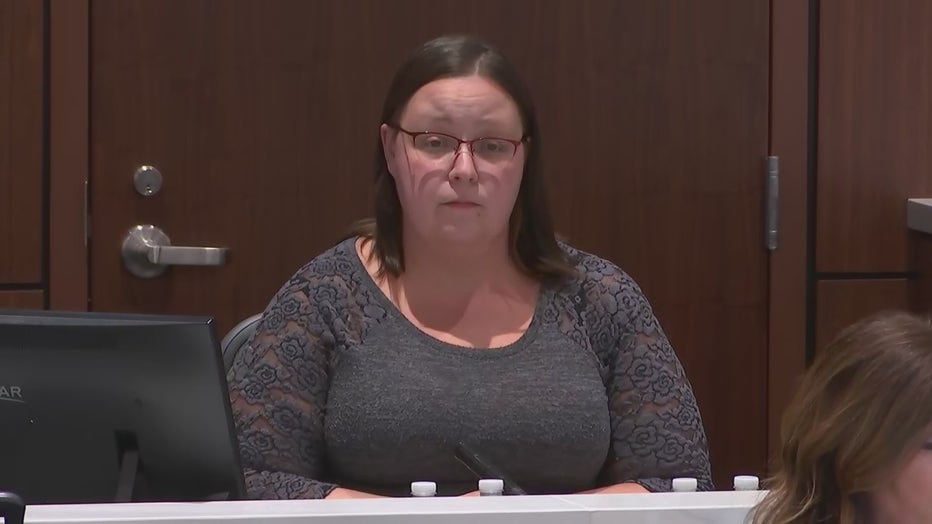
Hope Evans-Jansen
Hope Evans-Jansen said her daughter recorded video of the parade on her iPhone. She testified briefly about a video associated with the parade that she shared only with law enforcement and said not even family and friends had seen it.
On cross, Brooks asked Evans-Jansen if it was loud at the parade.
"Most parades I’ve been to have been loud," she said.
She said she couldn't see the driver or if there was anyone else inside the red SUV.
TESTIMONY: Michael Smith, Wisconsin State Patrol, accident reconstructionist
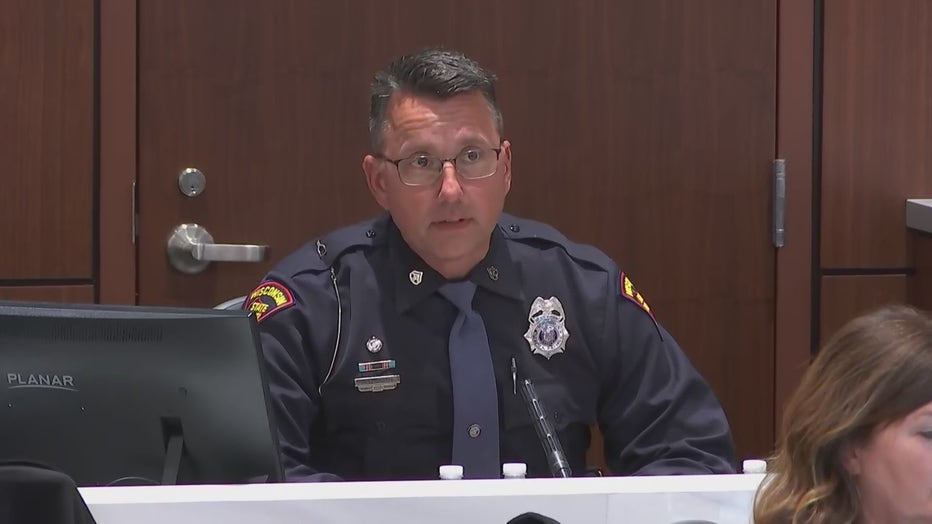
Michael Smith
Michael Smith, Wisconsin State Patrol accident reconstructionist, testified about the process he used in performing a speed analysis on the SUV. He testified that he calculated the average speed from "Point A" to "Point B" to be 32 miles per hour. That was his calculation of the speed of the red SUV on Main Street past Clinton, which he noted was an "average."
During cross-examination, Brooks asked Smith to explain Newton's law.
"It’s something we all learned in high school," Smith said.
TESTIMONY: Dr. Amy Sheil, Waukesha County associate medical examiner
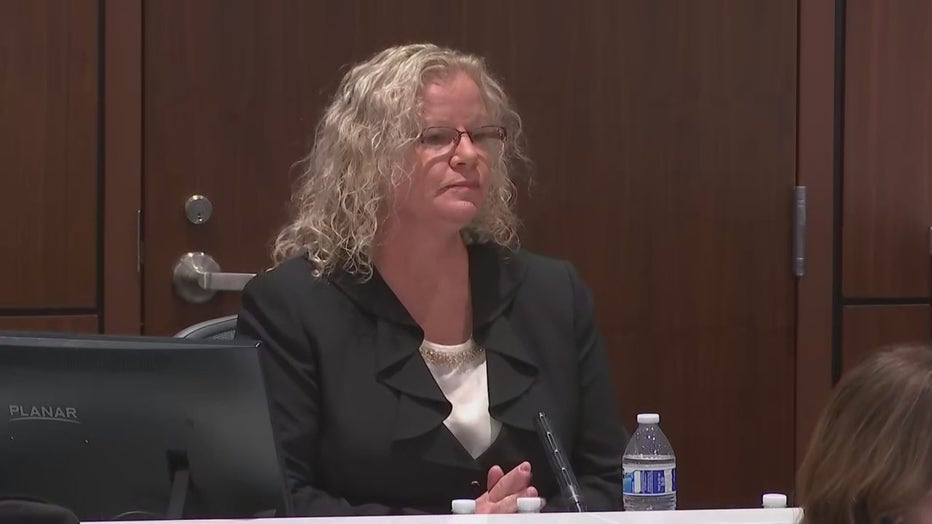
Dr. Amy Sheil
Dr. Amy Sheil, Waukesha County associate medical examiner, testified as to the autopsies of Lee Owen and Virginia Sorenson (Milwaukee Dancing Grannies member), and Jackson Sparks, 8, who was marching with the Waukesha Blazers. He died at the hospital. Sheil became choked up while testifying regarding Jackson's cause of death. Diagrams were shown, and the injuries were discussed in detail.
There was a long pause before Brooks' cross of Sheil after she held back tears while testifying about Sparks' death. He then spoke low, kept his head down and seemed to barely be able to get his questions out.
His cross was short, asking about when the victims were taken to the hospital. Sheil said Sorenson and Owen were pronounced dead at the scene, and Jackson Sparks was taken to the hospital; transferred to Children's Wisconsin.
Brooks then asked for a "moment," and the court took a 10-minute break.
TESTIMONY: Dr. Lynda Biedrzycki, Waukesha County medical examiner
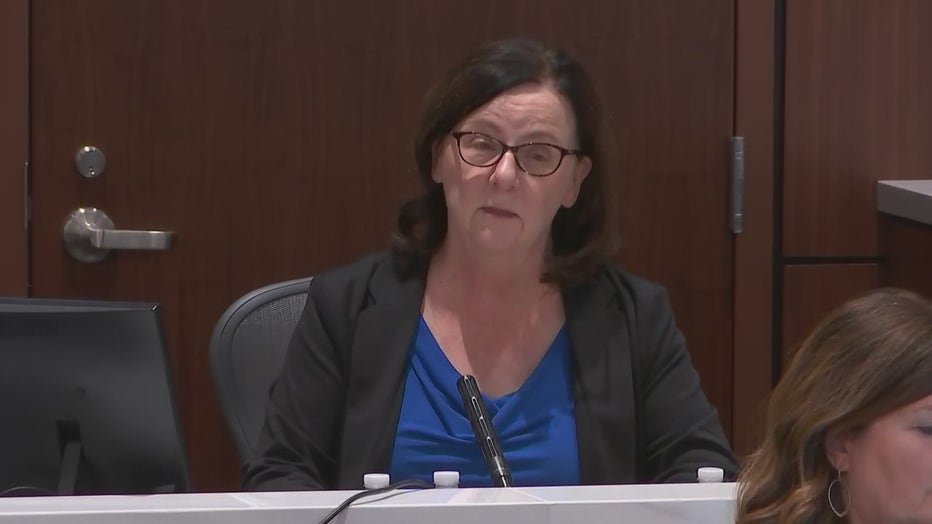
Dr. Lynda Biedrzycki
Dr. Lynda Biedrzycki, Waukesha County medical examiner, testified as to the autopsies of Tamara Durand (Milwaukee Dancing Grannies member), Jane Kulich (marching with Citizens Bank) and Bill Hospel (Milwaukee Dancing Grannies volunteer). Diagrams were shown, and the injuries were discussed in detail.
On cross, Brooks asked why she would examine a car being that she's in the medical field.
"The injuries that people sustain… it’s important to correspond the nature of the implement, the implement being the car, so it’s possible I would be shown a car that would be not consistent with the injuries," she said, adding that "examining the vehicle is important to interpret the injuries."
Brooks asked the medical examiner if she noted any natural diseases during the autopsies. She said Hospel had heart disease and a pacemaker. She remembered Kulich had a large fibroid -- a benign uterine tumor.
Biedrzycki was also asked by Brooks about the diagrams shown during her testimony, which she said she drew, noting that it took time to put them together because there were no diagrams available showing the front and back of the body and skeletal features, as her diagrams did.
On redirect, Deputy District Attorney Lesli Boese asked if all of the findings from her diagrams were from the initial autopsy work. She said "yes." Boese asked if she could have brought in a skeleton and described the same injuries.
"I could show you the broken bones on the skeleton. I couldn’t show you the injuries to the soft tissue or the organs on the skeleton," Biedrzycki said.
Boese asked if anything on the diagrams wasn't listed in the autopsy. Biedrzycki said "no."
Boese also asked if Kulich's uterine fibroid and Hospel's heart disease/pacemaker were factors in their deaths. She said "no."
TESTIMONY: Matthew Widder, Catholic Community of Waukesha priest
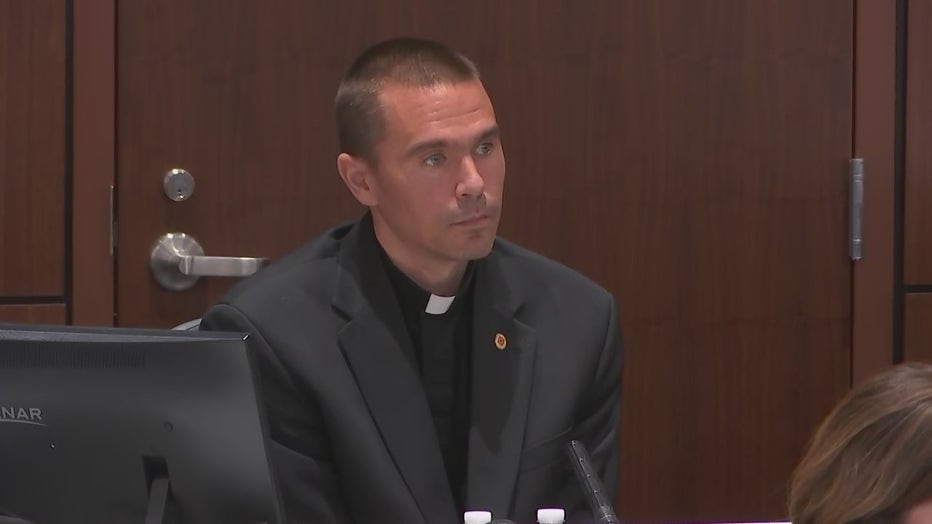
Matthew Widder
Matthew Widder, Catholic Community of Waukesha priest, testified he was walking in the parade with the group and saw three members of his group injured after the SUV came through. He said he did not see the driver because "the vehicle was going very fast."
"All of a sudden, we kind of heard a scream. I turned to my left, and there was an SUV just flying down the road…" he said. "My next experience would be kind of hearing it... collide into people."
Boese asked if he saw the SUV hit people.
"My mind blocks that part out of it, so I couldn't say who was hit in those impacts," he said. "What I can say is at my next encounter, there were three people from our group… that were lying more or less right in my immediate path."
He said he did not see the driver.
"I saw it just fly by, and my attention immediately was drawn to the three people that were on the ground in my vicinity," said Widder.
On cross, Brooks asked Widder why he would be testifying on behalf of an injured party if he wasn’t an injured party.
"My thought would be, as the pastor, I would have a more wide-ranging knowledge of people’s conditions as a pastor," said Widder. "That’s what I would assume."
Brooks then asked how he could assess the injuries "just by looking at the people."
Widder said he’s not a doctor, so he’s not the one diagnosing, adding "I can observe what I see."
Brooks asked why he would say the SUV was a car. Widder said he’s not a car person and uses the term as wide-ranging. Brooks asked if it would be fair to say he wouldn’t call a bus a car, and Brooks laughed.
Brooks asked if Widder saw anyone outside his group get hit.
"At the time of the incident, I had no idea what had taken place behind us," said Widder.
Widder was asked if he could see into the vehicle.
"The vehicle was going very fast, so I would not have had a picture of who was driving the vehicle," said Widder, who again testified the SUV was going "over 25 mph."
On redirect, Boese asked if Widder heard a horn honking. He said he personally did not.
TESTIMONY: Lukas Hallmark, Waukesha police detective

Lukas Hallmark
Lukas Hallmark, Waukesha police detective, was at the parade as a citizen with his wife and four children, ages 3, 5, 7 and 9; two were hurt. He testified about how, when he saw the SUV coming toward them, he threw his children toward the curb. He said, "Then as I looked back at all the kind of carnage behind us, my thought was that we were involved in some sort of terrorist attack." He also talked about the scene at the hospital with all the injured individuals, saying that, even being a police detective, "I’ve never seen anything like this in my entire life."
Hallmark was asked what he thought when he initially saw the red SUV.
"There was probably a lost motorist, and there was a vehicle traveling in the parade that shouldn’t have been there," said Hallmark, who said he had worked a parade in Waukesha. "After my initial thought of that vehicle was just a lost motorist, or they didn’t actually know what was going on, that thought faded very quickly and I realized that something was drastically wrong based on the fact that vehicle was traveling at a significant rate of speed towards our direction," said Hallmark.
He estimated the vehicle's speed at 30-40 miles per hour in the 25 mph zone.
Hallmark said he was clipped on his foot as the vehicle passed them. He was bruised and said his white sneakers had black marks he associated with tires.
After the vehicle passed to his right, Hallmark was asked if he remembered anyone getting hit.
"I don’t recall seeing anyone specifically getting hit," said Hallmark. "I do remember hearing sounds of the vehicle striking objects, and the only objects in the road were people at the time."
During cross, Brooks had one of the videos pulled up that was shown to Hallmark and questioned him as to how he could positively identify people, as he did during his testimony, if he could not see faces. Hallmark said he was "pretty confident," and then he followed up by saying he was "very confident."
Brooks also questioned Hallmark about his two kids' injuries and asked how he came to his determination about the SUV's speed. When asked if it was fair to say he doesn't know for sure how fast the SUV was going, Hallmark said, "That's correct."
Hallmark said he did not see his 9-year-old get hit, nor did he see anyone else get hit.
On redirect, Boese asked if Hallmark was 100% in the identifications he made in exhibits. He said "yes." When asked what that was based on, he said, "My recollection of the incident," versus the fact that he had seen the exhibits/videos previously.
FRIDAY, Oct. 14
The state called five witnesses -- including four police officers, some of whom were off-duty at the parade -- to wrap up the first full week of testimony in the trial.
The day began with threats from Judge Dorow to have Brooks moved to the adjacent courtroom after he began arguing about paperwork. Dorow noted 17 interruptions from Brooks on Thursday, not including his 50-minute rant.
Brooks kept up with his interruptions and demands of the court, Friday. Dorow proceeded to take another break to let Brooks "cool down" before testimony began for the day.
TESTIMONY: Craig Liermann, Franklin assistant police chief
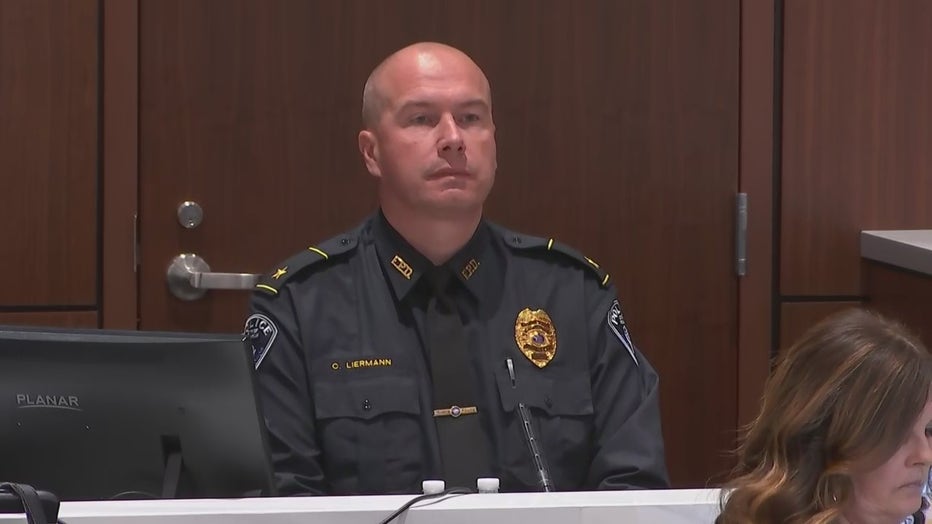
Craig Liermann
First to take the stand for the state Friday was Craig Liermann, assistant police chief for the Franklin Police Department.
Liermann testified that he attended the Waukesha Christmas Parade with his family as a civilian. He said he saw the red SUV barrel through the parade and that its engine was revving higher than normal. He also talked about how the SUV drove through the Catholic Community of Waukesha group.
"As it got closer, I was concerned there was a mechanical issue or a parade participant was having a medical emergency," Liermann said.
Liermann told the court he was roughly 10 feet away from the SUV, and that he got a good look at the driver, describing him in detail. He said the driver stuck his head out of the window and looked behind him "to the point that I thought he might fall out."
"When he drove through that group, he struck many of them, run over. I could see people come out from under the vehicle," Liermann said.
Liermann told the court he never saw the SUV slow down, never saw brake lights and never heard a horn honking from the SUV.
"There was no panic, no distress. It seemed to me like he was excited about what he was doing," Liermann said.
During his cross-examination, Brooks asked Liermann if the state was paying him to testify. He also asked if any video showed the SUV's driver hanging out of the window. Liermann answered "no."
"You saw the driver looking back, hanging out the window, looking all concerned – all in a few seconds?" Brooks asked. Liermann said "yes."
Brooks also asked if it was possible for a vehicle's engine in the wrong gear, causing the driver to lose control. Liermann said "I guess."
TESTIMONY: Ralph Salyers, Wauwatosa police officer
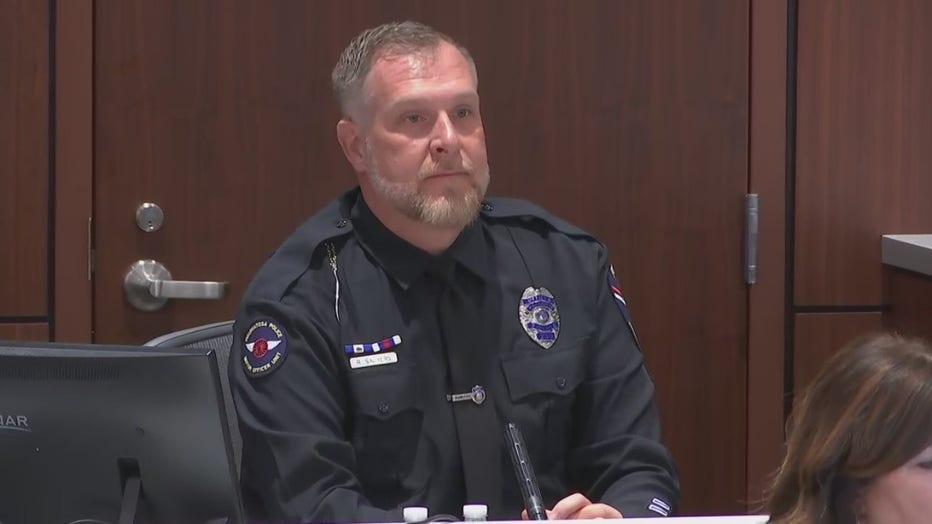
Ralph Salyers
Ralph Salyers, Wauwatosa police officer, said his daughters were walking in the Waukesha Christmas Parade with their dance team, and he attended as a civilian. He testified that he saw an SUV driving in an alley by Maple Road and heard a crash. He then observed the damaged SUV.
"I saw the driver come out and look at the front of the vehicle and yell, ‘(Expletive),'" said Salyers. "He appeared to be panicked. He went back and got items out of the driver's side of the vehicle and then ran southbound."
During cross-examination, Brooks asked Salyers how he was able to see the SUV turn down the alley and why he kept walking.
"I thought I witnessed a hit-and-run crash. I had no idea what happened at the parade," Salyers said.
Salyers added that he later walked over to the SUV and said there were no license plates on it. He also said he "recognized the driver when I saw him on TV and social media." Salyers identified the driver as Brooks.
TESTIMONY: Bryce Scholten, Waukesha police officer
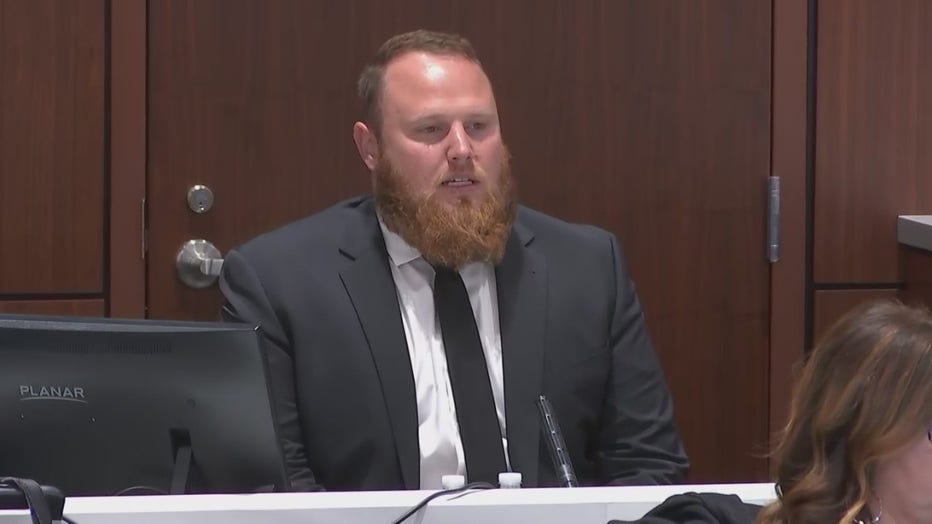
Bryce Scholten
Bryce Scholten, Waukesha police officer, told the court he was working on the parade route when he heard over his radio the call for service for a domestic disturbance in Frame Park. As he approached the parade route, he said he saw a red blur come past the Wisconsin House.
"I realized what had happened at that point. There was extreme damage to the vehicle that point. Damage you’d see in a traffic crash between two vehicles," said Scholten. "At that point, between all the screaming I heard, everyone calling for ambulances and help, I knew now people had been hit by a vehicle."
Scholten said he "had to use deadly force" and began shooting at the SUV as it passed him. He said the vehicle seemed so close he felt like he could've touched it.
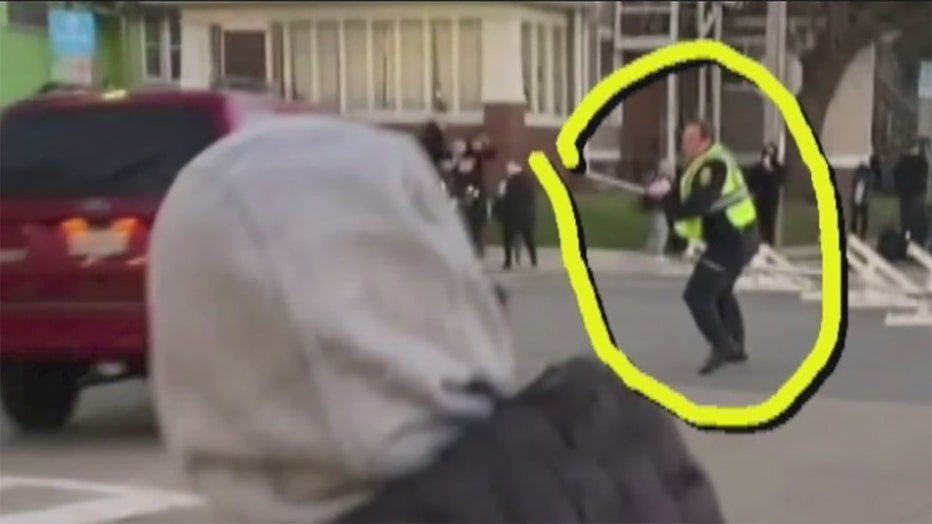
Scholten responds to red SUV, shown in court Oct. 14
The officer told the court he only saw one person in the SUV, and identified that person as Brooks.
Brooks started his cross-examination by asking Scholten about the Frame Park incident. He also asked if there were officers assigned to the parade barricades.
"Yes, this map shows, it appears, where everyone was for there assignments that day," Scholten answered.
Brooks also asked if the barricades would stop someone from wanting to exit the parade route and if they could drive right out if they were leaving.
"Yes – there are plenty of ways to get off the parade route," said Scholten.
Brooks asked Scholten if he was "shooting to kill," but Scholten said "no."
"I'm trained to stop the threat. You were the threat," Scholten told Brooks during questioning. "The vehicle was just what you were in and using."
TESTIMONY: Christopher Moss, Waukesha police officer
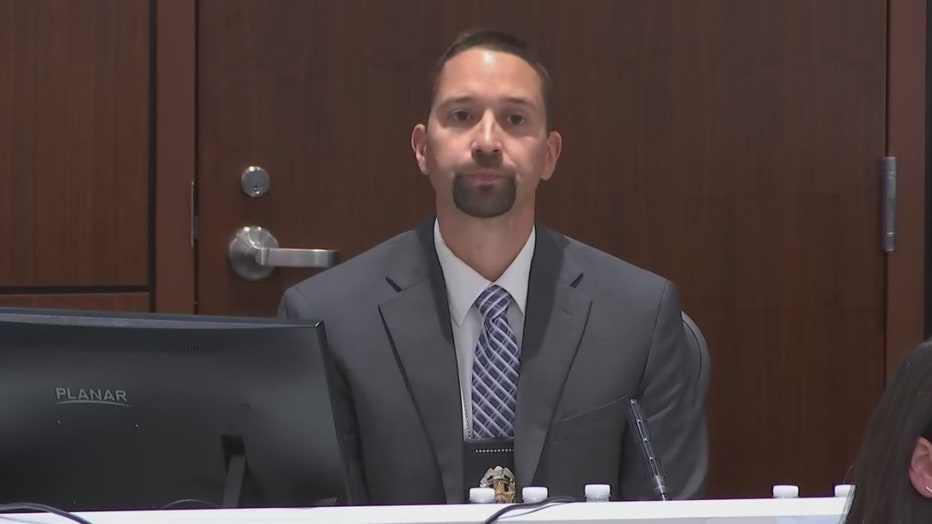
Christopher Moss
Christopher Moss, Waukesha police officer, said he marched the entire parade, leading it as a member of the Honor Guard/Color Guard unit. He later responded to the attack and was flagged down by a man who allegedly showed him to the red SUV parked in a driveway on Maple Road.
"I heard fellow officers screaming, requesting backup," Moss testified. "Upon arrival, it was absolute chaos. There were civilians on the ground in every direction I looked."
When he found the vehicle on Maple Road, Moss said, "There was clothing embedded in the hood."
The officer said the license plate came back to Brooks' mother, and another officer found Brooks a few blocks away. Also, Moss said paperwork inside the vehicle identified Brooks.
Brooks began his cross-examination, but the judge asked the jury to leave. Dorow told Brooks that his line of questioning for Moss – asking what the man who waved him down told him – was hearsay. When the jury was brought back in, Brooks mumbled under his breath.
Brooks continued his cross-examination, asking Moss if he knew if the vehicle was tampered with before he found it.
"Yes, it's possible," Moss replied.
At this point, the judge dismissed the jury to explain bias as it relates to the court Friday afternoon. Brooks was trying to ask witnesses about media coverage, and Brooks claimed the judge ignores his objections.
"I am an umpire of this court, sir," Dorow said.
"Are you kidding me?" Brooks replied.
Brooks accused Dorow of being unfair. Dorow told Brooks: "Your ignorance of the law is not a defense for any of this."
TESTIMONY: Carlos Arechiga Nolasco, Waukesha resident
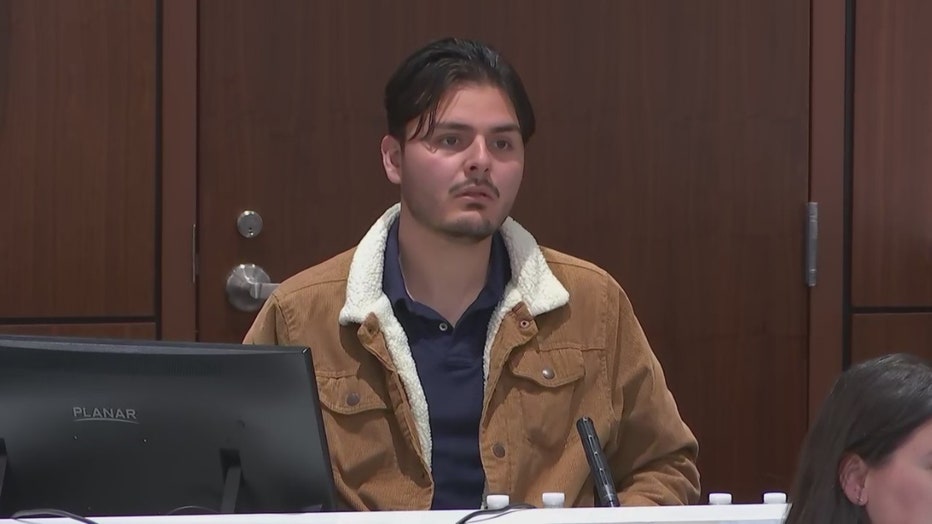
Carlos Arechiga Nolasco
Carlos Arechiga Nolasco testified he saw the red SUV park outside his home on Maple Avenue and saw someone get out and leave the area. He described damage to the vehicle and people running from the parade, apparently scared.
"My first instinct was, like, who is this? I hope our cars are OK," he said of finding the "beat up" SUV.
Upon cross-examination, Arechiga Nolasco again described the SUV as "beat up." Brooks asked the witness to describe how the person got out of the SUV. Arechiga Nolasco said the driver jumped over the hood.
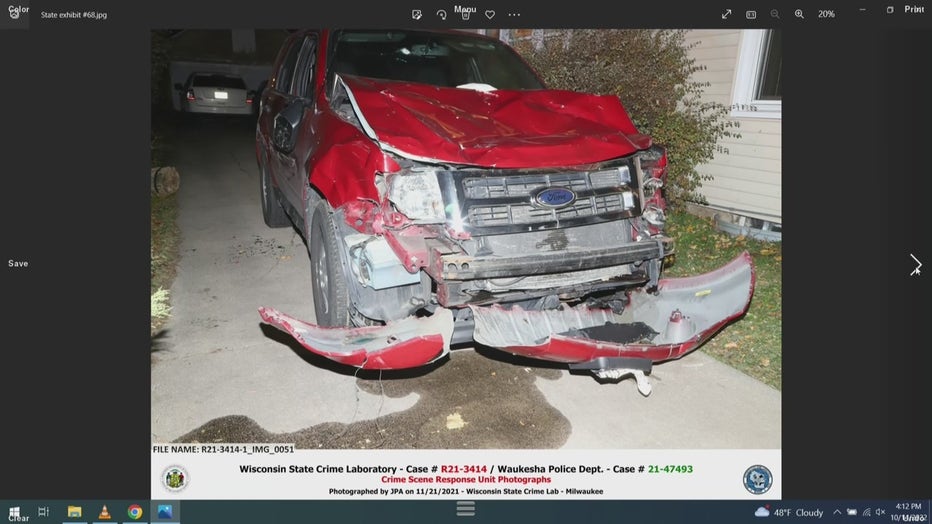
Brooks asked the witness to describe at length and define things like "evading" and "scratch." Arechiga Nolasco said he had peeked through his blinds after hearing a "big scratch" such as "metal on concrete."
Arechiga Nolasco also described some damage to the driveway and oil and debris that was left behind. He also said what he saw "happened in a flash," just a few seconds.
"Our house was sort of in the whole mess," Arechiga Nolasco said. "We were pretty shaken up – sort of scared, sort of frustrated, too."
The witness also reiterated seeing people, apparently scared, running from the parade. He added that police arrived "fairly quickly" after that.
Subject matter jurisdiction written ruling
FOX6 News obtained a document, filed with the court Friday, providing proof of jurisdiction after Brooks' repeated subject matter jurisdiction comments.
The court denied Brooks' request to dismiss for lack of jurisdiction without a hearing or further consideration.
The document notes, "This is a final order for purposes of appeal."
Waukesha County Sheriff's Department report on Brooks' conduct in court on Oct. 6
Also Friday, FOX6 News obtained a Waukesha County Sheriff's Department report on Brooks' conduct in court on Oct. 6.
The report detailing Brooks’ incident, when Judge Dorow ordered him to the adjacent courtroom, alleges Brooks "picked up his jail footwear and grabbed it like…a small club" and lunged toward deputies.
The report goes on, "shortly thereafter, [Brooks] removed his shirt." Deputies said he "started putting his hands into fists and flailing his arms out, like he was preparing for a fight."
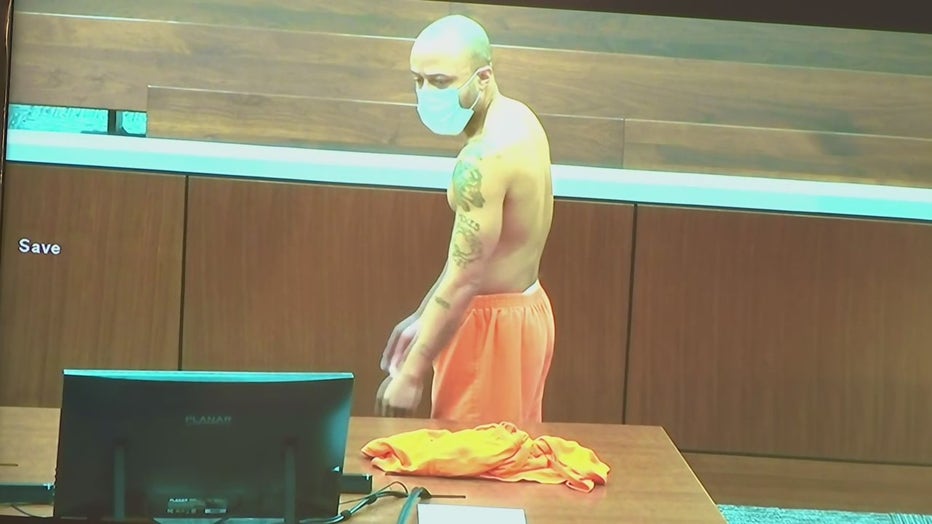
Darrell Brooks
On Monday, Oct. 3, deputies said Brooks was upset and stated if "someone touches him wrong, they will find out." Also on this date, Brooks asked if "the only way to get respect around here was to flip tables and throw stuff."
Also on Monday, Oct. 3, deputies noted Brooks got upset and swiped papers and a binder off his table and onto the floor.
On Oct. 6, deputies said Brooks complained of an "injury in a sensitive area" and asked if a male detective could photograph his injury.

